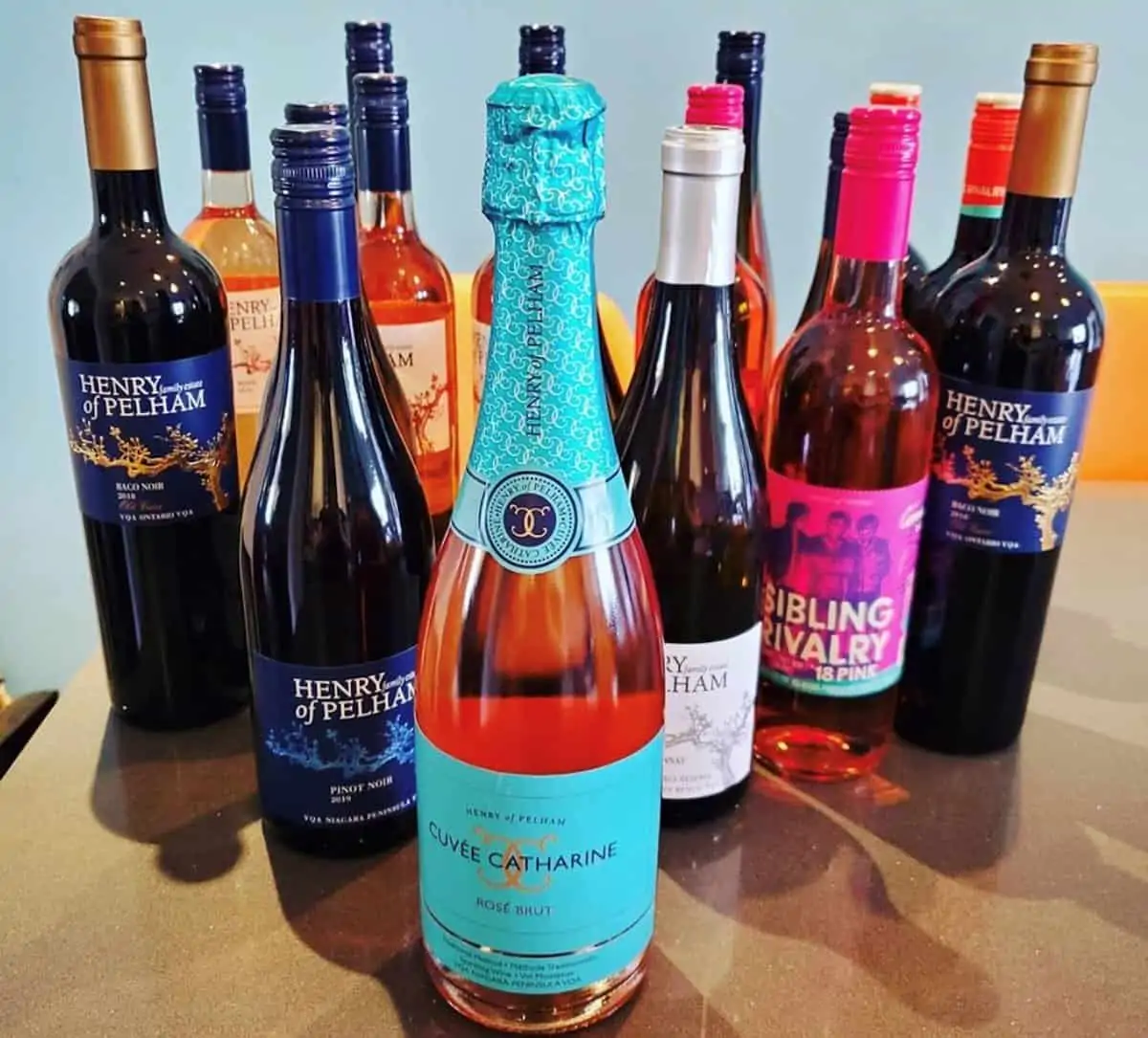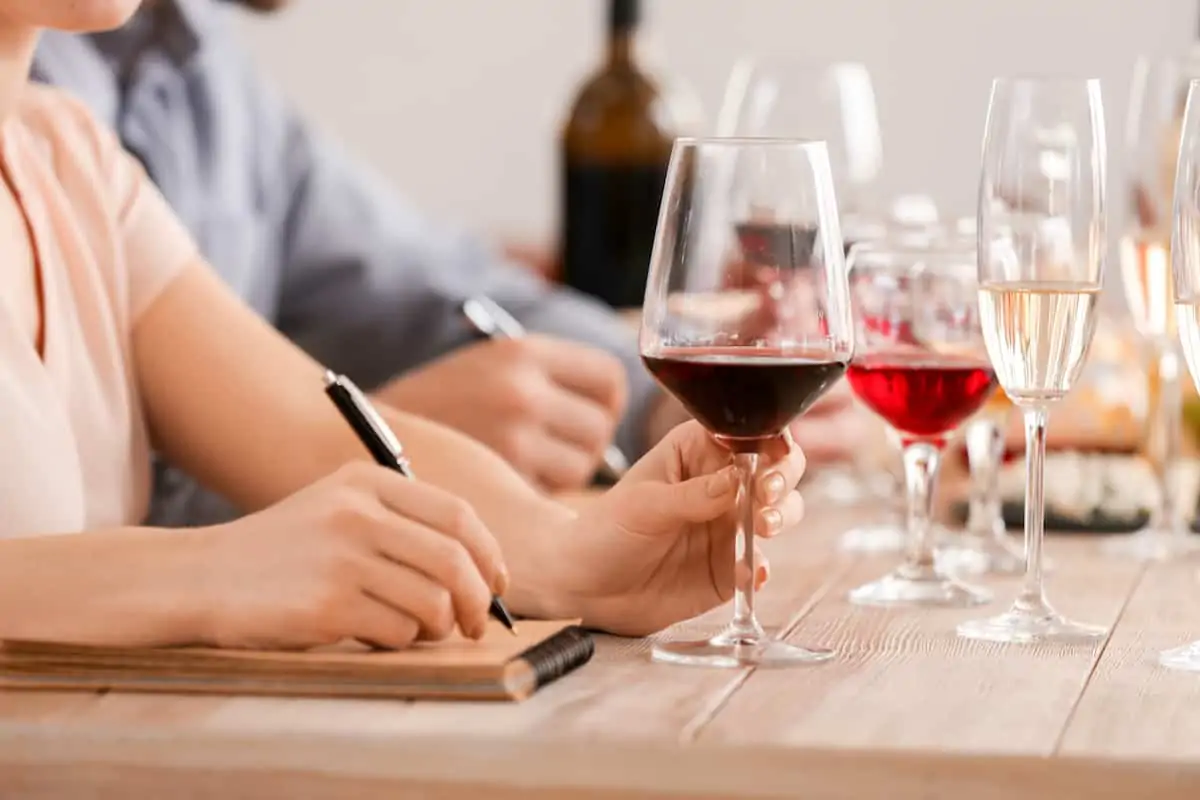We may earn income from links in this post. Please read this Disclosure for details.
If you’re a wine lover like me, you probably enjoy learning about wine as much as drinking the vino itself!
But what are the most important wine terms to know, and how can you make sure you’re using them correctly?
From acidity to Zinfandel, there are numerous terms important for both newbies and experts to understand about the language of wine.

In order to help identify the most important wine terminology, I asked the pros at Henry of Pelham for some tips. Henry of Pelham Winery is a family-owned, award-winning winery located in Ontario’s Niagara Peninsula.
If you’re a wine enthusiast, you need to check out the premium wine collection offered by Henry of Pelham.
The following guide is a layman’s look at the most important and widely used phrases associated with wine.
It focuses on how to describe wine, how to identify wine, and what terms to use when conducting a tasting whether it’s an icewine from the Niagara region of Canada, a Riesling from Germany or a red wine from Turkey.

Terms to Describe Wine
Here are the top four wine terms to know when describing wine:
- Appearance
- Bouquet
- Finish
- Taste
Appearance refers to the colour and clarity of the wine in your glass. A wine can be cloudy, transparent, or brilliant (just to name a few).
Bouquet is a wine tasting term that points to a particular wine’s mix of scents and smells.
Finish is a fancy way to describe aftertaste, and it really makes or breaks a wine. You can have a smooth finish, a spicy finish, or even a bitter finish.
When describing the taste of certain wines, common terms are crisp, soft, dry, fruity and oaky. Saying that a wine is crisp means that the wine has a refreshing acidity, where soft is a way to describe mouthfeel and usually means the wine has less acidity.
Dry is a sweetness level classification and means the wine is not very sweet. When someone refers to a wine as being fruity, it suggests that the wine has aromas and flavours of fruit. An oaky wine has smoky or toasted flavours, usually due to it having been stored in oak barrels.
Basic wine characteristics you can also keep in mind while enjoying a tasting are things like tannins and alcohol content. Tannins are astringent compounds that naturally occur in some fruits, and are responsible for those bitter tastes that can coat your mouth.
When harnessed correctly, tannins can actually produce a quite enjoyable taste. Tannins usually come from the grape’s skin, seeds, stems, or the wood barrels used in the aging process.
What is ABV?
Alcohol content or ABV (alcohol by volume), is the amount of ethanol found in any volume of liquid. The average ABV found in wines is around 11.5% to 12%.
Usually, higher alcohol content means that the wine will be less sweet, as most of the natural sugars have been converted to alcohol.
The exception to this would be with fortified wines, which tend to have a higher ABV, like port or other dessert wines.
These terms are helpful to keep in your back pocket when describing wine to other wine enthusiasts, or if you happen to be a server at a restaurant. Sometimes these terms can be subjective, so it’s important to try different wines yourself and trust your own palate.
While there are countless ways to describe wine, the above are the most common and paint a clear picture of what you or someone else might be looking for.
Ways to Identify Wine

There are many ways to identify wine when selecting a bottle. However, the most common descriptor is just the wine colour itself or the type (such as sparkling or dessert):
Red Wine
Red wine is made from dark-coloured grapes, and the skin usually stays on during the fermenting process. While it’s called red wine, the colours can range from a deep purple to a more brick red tone. Common grape varieties used in red wine are Merlot, Pinot Noir, and Zinfandel.
White Wine
White wine is made from lighter grapes, usually without the skin, which results in a more clear, straw-yellow or even green colour.
Common grape varieties used in white wine are Chardonnay, Sauvignon Blanc, Riesling and Pinot Grigio, and it’s normally enjoyed chilled.
Rosé Wine
Rosé is one of the oldest known types of wine and is created by incorporating some of the colour from grape skins, but not enough to turn it into a red wine.
It has a distinct pink hue and is usually a blend of different grapes, known for its fruity and often sweet flavour.
Sweet Wine
Sweet or dessert wine includes wines like port, vinsanto or icewine. They’re distinctively sweet and typically enjoyed after a meal. There are many different ways to make dessert wine.
It can be produced by adding sugar, either before or after fermentation, or by removing excess water to increase the concentration of sugar.
Sparkling Wine
Sparkling wine is wine made with higher levels of carbon dioxide. This process is usually reserved for white wines or rosé, however there are some examples of sparkling red wine (like the Italian Brachetto).
Champagne is probably the most famous example of a sparkling wine. However, a sparkling wine can only be called Champagne if it’s produced in the Champagne region of France. (It’s actually illegal to label a product as Champagne unless it comes from this area!)
There’s also sekt, a sparkling wine you’ll discover on a cruise of the Rhine in Germany.
Related: You might also like our recipe for Lobster Fettuccine featuring the white wine Viognier, a white wine grape variety.
Terminology to Use When Tasting Wine
In addition to the words that describe wine and identify it, the other important phrases to know are those related to qualifying taste.
These important wine terms are:
- Fruit Level
- Sweetness Level
- Body of the Wine
Fruit level doesn’t necessarily mean that the wine is sweet. It’s actually used to describe how much fruitiness the wine has in smell and taste.
Sweetness level, on the other hand, is exactly what it sounds like! It can range from bone dry (meaning not sweet at all) to very sweet.
When someone refers to the body of a wine, think of it in terms of how the liquid feels on your tongue. Another example of this would be the difference between skim milk and whole milk, where there is obviously a difference in body composition.
While shopping for wines at the LCBO, either online or in the store, you’re able to gain access to helpful information such as ABV, sugar content, the sweetness descriptor, style, and grape varietal.
Wondering if wine is gluten-free? Most wines are gluten-free but wines aged in oak or wooden barrels may contain traces of gluten. read this guide to wine and gluten for more information.
On the Henry of Pelham website they include all of the above as well as acidity, which describes how sour or tart a wine will be.
See, Swirl, Sniff, Sip, and Savour
You can also keep in mind the 5 S’s of wine tasting: See, Swirl, Sniff, Sip, and Savour.
When you look at the wine, notice the colour.
When you give it a swirl, you’re letting the air activate the wine, giving you a more robust experience.
Ask yourself: what do you smell? Notes of fruit, vegetables, or spice?
When you sip the wine, let it sit on your tongue for 3-5 seconds to experience its complex characteristics.
And lastly, by savouring the wine, you can tune into its finish and texture.
Other Wine and Spirits Posts You’ll Love!
- A Complete Guide to the Niagara Icewine Festival
- 7 Best Winery Tours in Santorini, Greece
- Top Wine Bars in Istanbul, Turkey
- A River Cruise Through Germany’s Moselle Valley
- Refreshing Boating Drinks for Summer
- Holiday Cranberry Prosecco Cocktail
Save to Pinterest!

Heather Koroluk is a Toronto-based freelance travel writer and photographer who enjoys exploring and showcasing the world of luxury travel, gastronomy, outdoor adventure, wellness and high-end fashion. Her print work has appeared in Canadian World Traveller and Taste & Travel International magazines.
Learn more about Heather Koroluk.





 Iced Cold Brew Hibiscus Tea (Fresco de Rosa de Jamaica)
Iced Cold Brew Hibiscus Tea (Fresco de Rosa de Jamaica)
ruth
Thank you, this was so helpful! I am always confused about wine, and this really made me feel more knowledgeable.
Amy B.
Thanks for explaining this in an easy to understand way! I’ve been wanting to get into wine pairings and this helps a lot!
Heather Koroluk
My pleasure Amy. Nothing quite like a nice wine pairing, enjoy!
Michelle Huston
Thank you so much for sharing your knowledge. Now, everytime I go for a glass of wine, I’ll actually know a thing or two.
Heather Koroluk
You’re welcome Michelle, cheers to your next glass!
Debra
Great read…I learned so many new things.
Kayla DiMaggio
This was such an interesting read! I don’t know much about wine, I just know I like drinking it! Haha! Thanks so much for teaching me all of the terms!